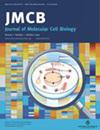HSD17B13 liquid–liquid phase separation promotes leukocyte adhesion in chronic liver inflammation
IF 5.9
2区 生物学
Q2 CELL BIOLOGY
引用次数: 0
Abstract
The rs72613567:TA polymorphism in 17-beta hydroxysteroid dehydrogenase 13 (HSD17B13) has been found to reduce the progression from steatosis to nonalcoholic steatohepatitis. In this study, we sought to define the pathogenic role of HSD17B13 in triggering liver inflammation. Here we find that HSD17B13 forms liquid–liquid phase separation (LLPS) around lipid droplets in the livers of nonalcoholic steatohepatitis patients. The dimerization of HSD17B13 supports the LLPS formation and promotes its enzymatic function. HSD17B13 LLPS increases the biosynthesis of platelet activating factor (PAF), which in turn promotes fibrinogen synthesis and leukocyte adhesion. Blockade of PAFR or STAT3 pathway inhibited the fibrinogen synthesis and leukocyte adhesion. Importantly, adeno-associated viral-mediated xeno-expression of human HSD17B13 exacerbated western diet/carbon tetrachloride-induced liver inflammation in Hsd17b13−/− mice. In conclusion, our results suggest that HSD17B13 LLPS triggers liver inflammation by promoting PAF-mediated leukocyte adhesion, and targeting HSD17B13 phase transition could be a promising therapeutic approach for treating hepatic inflammation in chronic liver disease.HSD17B13液-液相分离促进慢性肝脏炎症中的白细胞粘附
研究发现,17-β羟类固醇脱氢酶13(HSD17B13)的rs72613567:TA多态性可减少脂肪变性向非酒精性脂肪性肝炎的发展。在这项研究中,我们试图确定 HSD17B13 在引发肝脏炎症中的致病作用。在这里,我们发现 HSD17B13 在非酒精性脂肪性肝炎患者肝脏中的脂滴周围形成液-液相分离(LLPS)。HSD17B13 的二聚化支持 LLPS 的形成并促进其酶功能。HSD17B13 LLPS 可增加血小板活化因子(PAF)的生物合成,进而促进纤维蛋白原的合成和白细胞的粘附。阻断 PAFR 或 STAT3 通路可抑制纤维蛋白原合成和白细胞粘附。重要的是,腺相关病毒介导的人 HSD17B13 异种表达会加剧西式饮食/四氯化碳诱导的 Hsd17b13-/ 小鼠肝脏炎症。总之,我们的研究结果表明,HSD17B13 LLPS通过促进PAF介导的白细胞粘附引发肝脏炎症,靶向HSD17B13相变可能是治疗慢性肝病肝脏炎症的一种有前景的治疗方法。
本文章由计算机程序翻译,如有差异,请以英文原文为准。
求助全文
约1分钟内获得全文
求助全文
来源期刊

Journal of Molecular Cell Biology
CELL BIOLOGY-
CiteScore
9.60
自引率
1.80%
发文量
1383
期刊介绍:
The Journal of Molecular Cell Biology ( JMCB ) is a full open access, peer-reviewed online journal interested in inter-disciplinary studies at the cross-sections between molecular and cell biology as well as other disciplines of life sciences. The broad scope of JMCB reflects the merging of these life science disciplines such as stem cell research, signaling, genetics, epigenetics, genomics, development, immunology, cancer biology, molecular pathogenesis, neuroscience, and systems biology. The journal will publish primary research papers with findings of unusual significance and broad scientific interest. Review articles, letters and commentary on timely issues are also welcome.
JMCB features an outstanding Editorial Board, which will serve as scientific advisors to the journal and provide strategic guidance for the development of the journal. By selecting only the best papers for publication, JMCB will provide a first rate publishing forum for scientists all over the world.
文献相关原料
公司名称
产品信息
麦克林
D-fructose
阿拉丁
D-glucose
 求助内容:
求助内容: 应助结果提醒方式:
应助结果提醒方式:


